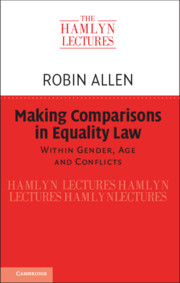Book contents
- Making Comparisons in Equality Law
- The Hamlyn Lectures 2018
- Making Comparisons in Equality Law
- Copyright page
- Contents
- The Hamlyn Trust
- The Hamlyn Lectures
- Preface
- Table of Cases
- Table of Statutes
- Chapter 1 Why Do Comparisons Matter?
- Chapter 2 Establishing an Effective Right to Equal Pay for Equal Work
- Chapter 3 Comparing Across the Ages
- Chapter 4 Comparisons When Equality Rights Are in Conflict
- Index
Chapter 2 - Establishing an Effective Right to Equal Pay for Equal Work
Published online by Cambridge University Press: 17 September 2020
- Making Comparisons in Equality Law
- The Hamlyn Lectures 2018
- Making Comparisons in Equality Law
- Copyright page
- Contents
- The Hamlyn Trust
- The Hamlyn Lectures
- Preface
- Table of Cases
- Table of Statutes
- Chapter 1 Why Do Comparisons Matter?
- Chapter 2 Establishing an Effective Right to Equal Pay for Equal Work
- Chapter 3 Comparing Across the Ages
- Chapter 4 Comparisons When Equality Rights Are in Conflict
- Index
Summary
This chapter discusses how the argument for a right to equal pay for work of equal value started and how it developed. It starts by noting that equal pay was promised during the Great War and then discusses the promises to implement it as a right in legislation in the following years, the failures to fulfil those promises and false steps, until the right became established. It then discusses the current problems with that right. Overall it explains the refusal to make substantive comparisons between men’s and women’s work.
Keywords
- Type
- Chapter
- Information
- Making Comparisons in Equality LawWithin Gender, Age and Conflicts, pp. 44 - 189Publisher: Cambridge University PressPrint publication year: 2020

